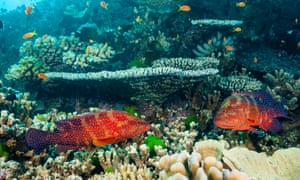https://www.theguardian.com/environment/2017/nov/29/great-barrier-reef-scientists-identify-potential-life-support-system
A group of “source” reefs have been identified that could form the basis of a life support system for the Great Barrier Reef, helping repair damage by bleaching, starfish and other disturbances.
Researchers from the University of Queensland, CSIRO, Australian Institute of Marine Science and the University of Sheffield searched the Great Barrier Reef for ideal areas that could potentially produce larvae and support the recovery of other damaged reefs.
The Great Barrier Reef is the world’s largest living structure and is made up of more than 3800 individual reefs, stretching 2300km down Australia’s eastern coastline.
The study found 112 “robust source reefs” – just 3% of the entire system – which had “ideal properties to facilitate recovery” of others by spreading fertilised eggs to replenish other areas.
“Finding these 100 reefs is a little like revealing the cardiovascular system of the Great Barrier Reef,” said Prof Peter Mumby, from the University of Queensland’s school of biological sciences and ARC Centre of Excellence in Coral Reef Studies.
Researchers had strict criteria – the reefs must be consistently well connected to other reefs through the constantly shifting currents, be less likely to die in a coral bleaching event and be less susceptible to crown-of-thorn starfish outbreaks.
These reefs were more likely to still be standing in the event of bleaching incidents, for example, and were in the right location to send fertilised eggs to the reefs that need them during the annual reproduction, Mumby said.
“It gives us a bit more hope that the capacity for the barrier reef to heal itself is greater than we expected.”
There have been four significant bleaching events on the Australian reef, including one this year. The longest and worst for the Great Barrier Reef was in 2016, when bleaching caused by climate change killed almost 25% of the reef.
Scientists have only recently been able to understand how connected the reefs are by ocean currents, Mumby said.
“The Great Barrier Reef is about the size of Italy and at any given time there are patches that have been damaged and patches that are pretty good, so it has an ability to heal itself if you like.”
The researchers used ocean circulation simulations to model the connectivity of the reef larvae across the Great Barrier Reef and generated 208 networks, through which the 112 strong reefs could reach almost half of all reefs through their “amazing capacity to connect the wider system”.
“It’s not perfect,” Mumby said. “There are areas in the northern barrier reefs where there are relatively few of these reefs identified.
“So some next steps are to relax the criteria and look at plan B and plan C.”
Associate professor John Alroy, from Macquarie University’s department of biological sciences, also noted the lack of the robust reefs in the north, saying the research paper was “thorough and interesting” but optimistic.
“That makes me wonder whether reefs in the far north can really be kept alive by being replenished from the south.”
Alroy also suggested many of the Great Barrier Reef’s animals would be absent from those reefs and suggested the paper did not fully acknowledge the worsening nature of climate change, which would probably also kill the robust reefs anyway.
Dr Andrew Lenton, principal research scientist at CSIRO Oceans and Atmosphere, said the report identified what was needed to maximise the capacity of coral to recover, including the protection of the robust reefs.
“It also recognises that this alone is not likely to be sufficient to ensure the longer-term viability of the Great Barrier as a whole and will need to be coupled with climate mitigation, local management and active management such as coral re-seeding.”
Mumby said new information about the reef and the way it functioned and repaired itself was readily adopted by the marine park authorities into its management plans, and received support from the federal government.
“This list of around 100 reefs is both a tangible and feasible set of intervention points to form part of a strategy for maintaining the systemic resilience of an ecosystem that is thousands of kilometres in scale,” the report said.
Tourism generated by the 2 million annual visitors to the reef contributes almost $6bn to the Australian economy.
The “life support” reefs identified in the study were good news, Mumby said, but more needed to be done to ensure the survival of the Great Barrier Reef.
In May scientists warned that the central goal of the government’s protection plan was no longer feasible because of the dramatic impact of climate change.
“It’s very clear that in order to maintain a beautiful reef into the future, we absolutely need to be much more aggressive in our response to climate change,” Mumby said. “We need coherent policies in government about what government is trying to achieve in our actions towards climate change and we need to continue to invigorate the local protections.”

沒有留言:
張貼留言